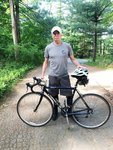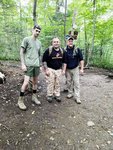



Vietnam veteran Dave Nichols, a double amputee from Connecticut who’d spent nine months recovering after his return to the U.S., decided almost on a whim to follow a friend to Sullivan County Community College. He’d been awarded the Purple Heart and Bronze Star; now he needed to figure out how to build a new life.
Five decades later, the Stone Ridge resident – now a happily married father of three and grandfather to five – served as honorary chairman for the Hudson Valley National Center for Veterans Reintegration’s second annual Day of Golf Fore! Veterans, held at Wiltwyck Golf Club on, Sept. 9. The event raised funds to continue HVNCVR programs designed to help veterans and active-duty military and their families return to civilian life.
College, says Nichols, had been a great starting point. “I wasn’t really academic, but it turned out I liked it, so I went on to SUNY New Paltz,” he says. “I studied liberal arts and anthropology, which helped me develop my critical thinking skills.” He also fell in love with the area, with its beautiful surroundings and “people from every walk of life, all types of ethnic backgrounds and perspectives.”
About eight years after coming home, Nichols played his first round of golf. “It was the perfect vehicle for me,” he says. “It put enjoyment back into my life. I was networking with people, traveling, getting out – I think an important point for a lot of vets is finding something that gets you off the couch, so you don’t withdraw.”
Once he got off the couch, Nichols discovered he could do a lot more than he’d ever imagined. He trained in boxing with local legend Billy Costello and went on to coach others, took to the trails on a bike, and became an instructor in Wyndham’s Adaptive Skiing program.
But golf has held a very special place in his life. “It’s just been the perfect vehicle for me,” he says. “You can play by yourself or with all kinds of people, play a serious tournament or a rowdy scramble. You can go anywhere in the country or the world and play in a beautiful parklike setting.”
He’s done just that. “Nichols has placed in the top 30 in national amputee tournaments in Prince Edward Island, Canada, and New Hampshire,” reads a 2011 story about him in the sports pages of the Times Herald-Record. The article also notes that on a good day at the Rondout Valley Golf Club, he’d typically shoot a 78 – and that he interspersed his golf travel with three trips a year to visit wounded soldiers at Walter Reed Hospital, visiting patients while wearing shorts, to talk about the joys of life off the couch.
“Sports can wake up that interest, give you back a sense of direction,” he says. “You assume you can’t do something, and then you get an opportunity to try, and life changes. And thanks for not focusing on the circumstances that led to this 50 years ago. It was a lifetime ago, and life’s gone on.”
For more information on the Hudson Valley National Center for Veterans Reintegration , call 845-399-9561.
Veterans of the armed forces have been trained to meet enormous challenges without flinching, but once they’ve served, overcoming post-traumatic stress and injury and getting reconnected to everyday life can feel like the biggest challenge yet. Nationally, we lose about 20 vets a day to suicide; an estimated 49,000 are homeless.
It’s a situation that the government has been unable to fix, especially given that every single vet lives a different story before, during and after deployment. Modern medicine can do wonders for physical injuries, but who can truly speak to a tired veteran’s soul?
Other veterans, that’s who. The grassroots Hudson Valley National Center for Veterans’ Reintegration (HVNCVR), based in Kingston, offers a wide range of programming designed to help those who’ve served re-establish themselves here at home.
The organization’s “Why” section on its website summarizes the problem. “We’re taught to deal with physical pain and emotional discomfort, ‘to suck it up’ and not complain, doing whatever it takes to complete the mission. During active service the reality is this is sometimes necessary. Unfortunately, many of us carry this mindset into the civilian world. As Veterans adjusting to civilian life, we can isolate ourselves, avoid help, and become increasingly alone, not realizing help is available to us. “
The help offered by the HVNCVR comes in many flavors and is available to all veterans, regardless of rank, branch or discharge status, and to active service members on leave looking for support. Programs include traditional martial arts, Warrior Writers, a wooden boat workshop, wilderness retreats, and a wood shop, along with financial readiness and other workshops offered through the center’s peer-based Vet2Vet program.
“So I went to Afghanistan, came back, and had a hard time,” says Kevin Keaveney, HVNCVR executive director and one of its founders. “I was a blue collar guy, no formal education; I decided to go back to school. I was trying to find things to take my mind off my memories, so I started building a boat in my backyard. It grounded me. It felt good. My family was engaging with me around it. At the time I didn’t realize what it was that I was doing. It was simple stuff, but it was occupational therapy.”
Still struggling, Keaveny sought counsel from a fellow vet, retired sergeant Frank Ruggiero. “I went in there whining and complaining and Frank just stopped me and said, ‘What do you want to do?’ I said, ‘Jeez, I don’t know. I like working with vets and I like building boats.’ And something just clicked. Why not do that?”
Keaveny had been studying IT, but once he set off in his new direction the flow took over. “I went to the Rondout Yacht Basin in Connelly to talk to the owner, Andrew Rothlein, about a kayak-building program for vets. It turned out his father had been a combat vet. I had this whole speech planned, and two sentences in he just said yes. So we threw some tents up, got a bunch of lumber, and started reaching out to vets who’d just come back.”
The chemistry was immediate. “The good side of service – that brotherhood and sisterhood, that bond – started reemerging immediately. Some vets kept coming back just to be around other vets. I realized not every vet was going to want to build a boat, so we started looking for other ways to engage people.”
A team evolved to help expand those ways. “Rich Cattabiani has been beyond amazing. Jillian Nadiak-Bruck – she’s a black belt, she’d hurt me if we sparred – lost her veteran brother to an opioid overdose and then started the Nadiak Foundation to help folks get educated in human services. She’s a board member now, and the co-creator of our Warrior Writers workshop. That’s another incredible program – they give prompts that help elicit things, talk for 20 minutes, and then you just write about whatever comes into your head. The healing that goes on there is amazing. Really, anything that will help a vet, a family member or service member ... I don’t care if it’s making pink polka-dotted hula skirts, I’m all about it.”
One of the Center’s core programs, Vet2Vet, is the Ulster County branch of the Joseph P. Dwyer Veteran Peer Support Project, named in honor of a brother gone too soon. “He was a combat medic. Google him and you find a famous picture of him in Iraq helping a child,” says Gavin Walters, a U.S. Air Force veteran who manages the program within the HVNCVR.. “It’s just what we do. They talk about honor, respect and glory, but Joseph ended up self-medicating. He was always asking for help, but couldn’t get any, even when he reached out to the VA. He died in 2008 of an overdose.”
In Dwyer’s memory, the program launched its one-to-one peer services program in Suffolk County in 2012; Ulster and Sullivan Counties became the 24th and 25th branches last year. “Vet2Vet just encompasses what the center has always been doing, coming together in camaraderie and advocacy,” says Walters. “The conversations lead to connecting veterans to resources that will help them and their families. Our network is like a body with movable pieces connecting to a community of veterans, so whether you’re down in Plattekill or up in Saugerties you can reach out and connect to food and resources, telemedicine, AA meetings, whatever will help.”
Like any big bureaucracy, the Veterans Administration can be a mixed bag. “Dealing with the VA can give you a whole lot of emotions,” says Walters. “Some will go 1,000 miles to help; others are not so good at listening and just go by the chart. It’s a spectrum. The experience can be amazing, or ... Like everything about this, people who haven’t lived it often don’t fully understand.”
That, says Walters, is what’s crucial about events like Walk-A-Mile In My Shoes, which took place last Sunday into Monday as vets and their supporters took a 22-hour, 56-mile walk from Kingston to Albany. “Police, Red Cross, Girl Scouts – all kinds of people come and meet us and walk with us,” says Walters. “If we can walk through the night, do 22 hours, it demonstrates to the community that you’re not alone if you’re going through a situation. There is always someone here to walk beside you through the million steps that make a day.”
Last week, Keaveny was organizing gatherings so vets could decompress from the triggering pressure of recent events. “I just want us to share the understanding that what’s happened in Afghanistan doesn’t reflect on our level of service,” he says. “There’s love for the positive aspects, but what we do over there doesn’t necessarily translate smoothly back home, and the language and humor can freak people out.
“But the honor and dignity, those work well here so far, and I’m proud of that. And the camaraderie is helpful. One brick at a time, we start taking down those walls we’ve had to build.”
Building of a different sort is on Keaveny’s mind these days – the HVNCVR is planning a tiny-house community. “When we first got started, ‘national’ wasn’t part of the name. We didn’t want people to think we were a branch of something,” he says. “What it does mean is that we are open to vets from all over the country; they can come here to the mountains and water and work with us. It’s a beautiful, healing place. And we want a tiny-house community to host them and also provide transitional – and some permanent – housing for homeless vets.”
As deeply serious as their life-saving mission may be, the vets of HVNCVR regularly crack each other up. Last year’s Vets on Water event featured a climb up Mount Marcy toting a giant pink unicorn.
“The picture made it into VFW Magazine,” Keaveny recalls. “Then there’s the experience of watching a Marine vet, a Purple Heart recipient, getting blown around floating on it, yelling ‘How do I get back in?!’ This year we’re doing Vets on the Hudson, paddling from Kingston down to Fort Montgomery, sleeping in the dirt on the riverbank, from Sept. 29-Oct. 4. We’ll be live streaming a fireside chat between vets and local officials on our Facebook page from Quiet Cove Park in Poughkeepsie.
“We live-streamed last year’s Vets on Water too; it was hilarious. The theme was ‘Live.’ Just do things. Get out there. If we cranky old vets can do it, so can other vets. So can you.”
For more information on the HVNCVR, visit HVNCVR.org, call 845-481-4004, or find Hudson Valley Center for Veteran Reintegration on Facebook.